As the world moves inexorably – albeit at times fitfully – towards greater globalization, the third sector is assuming new roles. The growing recognition that local and global fortunes are intertwined has been leading more foundations and other donors to look beyond their own backyards and to examine new funding directions and formulate new operating agendas. The Middle East region, and the Israeli-Palestinian axis in particular, serves as a case in point, with foundations hitherto not engaged in the region at all beginning to explore its needs and examine ways in which they might become involved.
Both Israel and the Palestinian areas boast active NGO sectors that have long contributed to the growth of civil society and to the social, cultural, educational, agricultural and health sectors of their respective societies.
Reaching across borders
Over the past decade and more, some NGOs have reached out across borders to forge links with each other. Many such cross-border interactions began prior to the current unrest in the region and continue despite its further deterioration. Clearly, people and organizations on both sides of the border are seeking ways to maintain communication and foster cooperative undertakings even though interaction at the official level has all but broken down. In a sense, NGO interactions have evolved into a sort of ‘second track’ of Israeli-Palestinian communication, which is keeping alive the vision of ultimate peace and coexistence in the region. Funding for many of these efforts has been forthcoming from international organizations, donor governments, foundations, international corporations and individuals.
The recently completed Middle East Study Missions for Foundations programme, co-hosted by NGOs in Israel, Jordan and the Palestinian areas, introduced foundation leaders from the US, Europe and Asia to a weave of local concerns and regional imperatives. During the course of these missions, in addition to briefings and site visits, participants also met with a wide range of NGO leaders, which gave them a first-hand view of the capabilities and efforts of these groups. The meetings themselves served as catalytic events with a great deal of exchange and cross-fertilization of ideas and operational suggestions.[1]
This programme is one of many efforts, both past and present, whereby NGOs and the foundations, individuals and donor groups that support their activities have combined to sustain these positive interactions, ranging from simple communication and exchange – at times currently occurring in locations out of the region – to cooperative projects on the ground. Able to transcend the more political aspects of the current Middle East situation, flexible in their approach and prepared to take risks, NGOs and funders together are serving a positive peace-building role. Today, when other channels of communication have been stilled, the significance of this cannot be overstated. However limited their scope, however different the narratives espoused by each side, the mere fact that these interactions are being sustained at all is positive and promising. Without the active role played by donors, and without the willingness of individuals and NGOs throughout the region to participate, these sparks of hope would die out.
1 A full report of this programme is available from the Van Leer Jerusalem Institute, which coordinated the effort. To obtain a copy, write to S Soreni, Van Leer Jerusalem Institute, PO Box 4070, Jerusalem, Israel or email vanleeer@vanleer.org.il
Dorothy Harman is Director, Department of International Operations, the Peres Center for Peace. She can be contacted at d.harman@peres-center.org
The Peres Center for Peace
The Peres Center is an Israeli NGO entirely devoted to the promotion of peacebuilding and coexistence in the Middle East. Together with partners in the neighbouring countries, it has launched a wide range of programmes and projects directed at the development of civil society and the advancement of economic, social, cultural and educational sectors, as well as a host of people-to-people interactions. Largely financed by international organizations, donor governments, foundations, corporations and individuals, it stands as an example of the positive role that can be played by the third sector. Its experience has been that at times of adversity, such programs can continue to provide real examples of the potential benefits of communication and cooperation.
See http://www.peres-center.org





Comments (0)